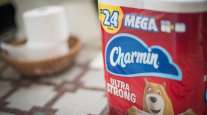Walmart Bounces Back With Best Sales in More Than a Decade

Walmart Inc. bounced back from a lackluster start to the year with the strongest sales gain in more than a decade fueled by its grocery business, brightening the outlook for the overall retail sector. The stock jumped as much as 11%, the most intraday since October 2008.
Comparable sales at U.S. Walmart stores rose 4.5% in the three months ended in July, the company said Aug. 16, more than double analysts’ estimates. Grocery sales rose the most in nine years thanks to improved fresh-food offerings, and web revenue growth accelerated from the previous period. The world’s biggest retailer also boosted its full-year forecasts for comparable sales and adjusted profit. Walmart ranks No. 3 on the Transport Topics Top 100 list of the largest private carriers in North America.
RELATED: US retail sales rose at 0.5% annual rate in July
It was “a banner quarter on multiple fronts,” Charlie O’Shea, an analyst at Moody’s Investors Service Inc., said in a note. “The food business continues as a bright spot.”
Walmart has benefited from improved consumer sentiment and tax cuts that have put more money in Americans’ pockets this year. U.S. retail sales rose by more than forecast in July, as shoppers snatched up apparel and school supplies. But investors remain somewhat skeptical that brick-and-mortar retailers can keep pace with online rivals such as Amazon.com, evidenced by Macy’s shares plunging Aug. 15 despite boosting its earnings and sales guidance.
“We’re pleased with how customers are responding to the way we’re leveraging stores and e-commerce to make shopping faster and more convenient,” Walmart CEO Doug McMillon said in a statement. “We’re continuing to aggressively roll out grocery pickup and delivery in the U.S., and we recently announced expanded omnichannel initiatives in China and Mexico.”
Grocery Strength
The company now offers curbside pickup of online grocery orders in 1,800 U.S. stores, and Chief Financial Officer Brett Biggs said in an interview that the service is bringing in new customers.
Another bright spot in the second quarter was the Sam’s Club warehouse chain, whose comparable-store sales increased 5%, more than double analysts’ estimates, marking the strongest quarter in six years.
Walmart’s shares rose to as high as $100.21 in trading Aug. 16, bringing the stock’s gain this year to under 1%.
Better Weather
Biggs said the retailer benefited from improved weather in May, the first month of the quarter, which led to the biggest quarterly gain in customer traffic in more than six years. Some customers made fewer shopping trips during the cold, wet April.
“Customers tell us that they feel better about the current health of the U.S. economy as well as their personal finances,” Biggs said. “With warmer weather, sales of seasonal items like pools, air conditioners, swimwear and gardening supplies really popped in May compared to April. No doubt we were aided by tailwinds during the second quarter.”
For the full fiscal year, Walmart expects comparable sales, excluding fuel, of about 3% at both name-brand stores and at Sam’s Club. It had earlier been expecting growth off at least 2% at Walmart stores and slightly negative to flat performance at the bulk chain.
The retailer now expects full-year adjusted earnings per share of $4.90 to $5.05, excluding the sale of its majority stake in Walmart Brazil, losses related to its JD.com investment in China and tax adjustments. That’s up from the $4.75 to $5 it had been expecting previously.
It had earlier said it would have to trim its full-year profit forecast to account for its acquisition of a majority stake in Indian e-commerce merchant Flipkart, which hasn’t yet been incorporated into the forecast.
“If you are a Walmart bull, there are many reasons to be bullish today,” Edward Jones analyst Brian Yarbrough said in an interview. “They did benefit from pent-up demand, but let’s give ’em credit: It was a very solid quarter.”
— With assistance by Karen Lin, Fei Fang Lim, and Jonathan Roeder.




